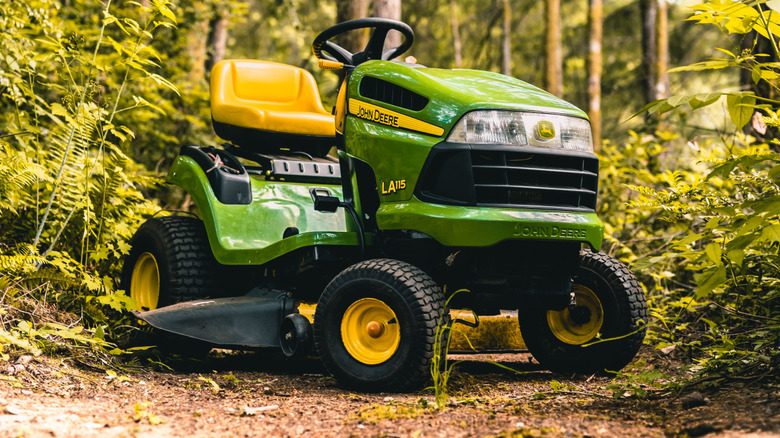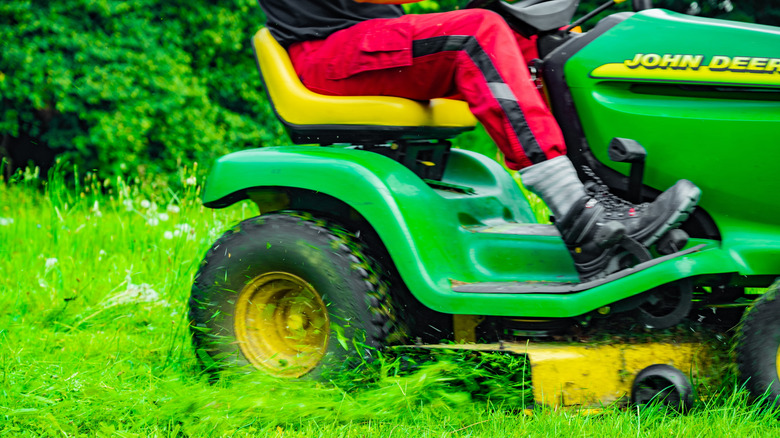How To Winterize Your John Deere Lawn Mower (And Why You Should)
The arrival of the winter season can mean a lot of things. The holidays, frantic online and in-person shopping for said holidays, and plenty of snowfall and ice formation. With all of this is the changing of the guard, from the summer outdoor tools to the winter ones, with shovels and snowblowers taking over for rakes and lawn mowers. Thus, in the process of getting out your seasonal arsenal, which could include practical tools like those from Ryobi to keep you prepared for winter weather, you have to put away those that won't see much use until the warmer months.
Storing away some tools during the winter isn't much of a hassle. Simple hand tools can just be tucked in a drawer or hung up on a rack without issue. However, once one gets into mechanical tools, proper preparation and storage become essential. For instance, if you have a John Deere mower, you want to make sure it's well-prepared for the low temperatures ahead.
This is where the winterization process comes in. In a few steps, you can prevent a litany of issues like fuel gelling, dirt and debris clogging up the internals, and internal oil corrosion that can cause headaches in the summertime and shorten the lifespan of your mower overall. To get the most out of your John Deere mower, here's what you can do to keep it in the best shape possible as it waits out the winter.
The John Deere mower winterization essentials
When winterizing a John Deere lawn mower, there are a few essential steps to take. The first is addressing remaining fuel. As mentioned, if gasoline sits within over the winter, it can lead to gelling, clogging up your mower, and creating rust. You can empty the remaining fuel with a siphon or baster, then run the engine until the leftover fuel is gone, or fill the tank fresh and add fuel stabilizer. Run the engine for a bit to get everything flowing, and this task should be all set for the winter.
Next, remove your mower's battery and safely store it. Turn the mower off completely, then remove the negative and positive contacts in that order, then take the battery out of the mower. From here, you can wipe it down to remove dirt and any corrosion and put it in a cool, dry area. Otherwise, the frigid winter temperatures can harm the battery's cells, reducing the battery's effectiveness and the amount of use you can get out of it before having to get a new one.
Also, you should give your mower a good cleaning, seeing as moisture trapped in by debris can cause corrosion and rust formation. A rinse with the hose to remove dirt, grass clippings, and other remnants can go a long way, especially if you scrub off especially stubborn materials. Getting the underside of the deck and mower blade as clean as possible is essential to this routine, too. If your blade looks dull, it's not a bad idea to change it on your own before the next mowing season. With winterizing complete, you should store your mower indoors and cover it — that is, unless you invest in a snow blower or snow blade attachment for your snow removal needs.
The importance of winterizing a John Deere mower
Winterizing your John Deere mower effectively is crucial to keep it in workable condition. Treating your fuel system keeps it flowing freely and mitigates obstructions that can reduce performance in the summer and cause internal rust. Cleaning thoroughly reduces the likelihood of rust and degradation due to retained moisture held by caked-on grass. Removing the battery for the season maintains its cells and keeps it on track to have a normal use period. If all of those winterizing tips and their benefits don't feel like enough, or you just want to be thorough, there are some additional mower maintenance steps that are very much worth taking before winter.
Next up, you've got some replacing to do. Putting in fresh air and fuel filters prevents dirt and other debris from reaching the carburetor. Replacing the oil and oil filter, assuming you've exceeded around 50 hours of use since the last replacement, is key. Don't forget to let the engine run for a bit after replacing, this way the new oil is distributed thoroughly.
Finally, replace the spark plugs since they should be replaced at least once a year. This process involves removing the old spark plugs, cleaning the new spark plug gaps, adding a bit of oil to the cylinders, and carefully inserting new ones. With the winterization and cleaning processes complete, you can feel comfortable storing your John Deere mower away for its winter vacation.


